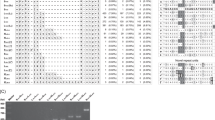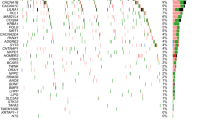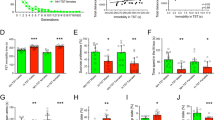Abstract
Tryptophan hydroxylase (TPH), being the rate-limiting enzyme in the biosynthesis of serotonin plays a major role as candidate gene in several psychiatric disorders. Recently, a second TPH isoform (TPH2) was identified in mice, which was exclusively present in the brain. In a previous post-mortem study of our own group, we could demonstrate that TPH2 is also expressed in the human brain, but not in peripheral tissues. This is the first report of an association study between polymorphisms in the TPH2 gene and major depression (MD). We performed single-nucleotide polymorphism (SNP), haplotype and linkage disequlibrium studies on 300 depressed patients and 265 healthy controls with 10 SNPs in the TPH2 gene. Significant association was detected between one SNP (P=0.0012, global P=0.0051) and MD. Haplotype analysis produced additional support for association (P<0.0001, global P=0.0001). Our findings provide evidence for an involvement of genetic variants of the TPH2 gene in the pathogenesis of MD and might be a hint on the repeatedly discussed duality of the serotonergic system. These results may open up new research strategies for the analysis of the observed disturbances in the serotonergic system in patients suffering from several other psychiatric disorders.
This is a preview of subscription content, access via your institution
Access options
Subscribe to this journal
Receive 12 print issues and online access
$259.00 per year
only $21.58 per issue
Buy this article
- Purchase on Springer Link
- Instant access to full article PDF
Prices may be subject to local taxes which are calculated during checkout
Similar content being viewed by others
References
Kessler RC, McGonagle KA, Zhao S, Nelson CB, Hughes M, Eshleman S et al. Lifetime and 12-month prevalence of DSM-III-R psychiatric disorders in the United States. Results from the National Comorbidity Survey. Arch Gen Psychiatry 1994; 51: 8–19.
Malhi GS, Moore J, McGuffin P . The genetics of major depressive disorder. Curr Psychiatry Rep 2000; 2: 165–169.
Fitzpatrick PF . Tetrahydropterin-dependent amino acid hydroxylases. Annu Rev Biochem 1999; 68: 355–381.
Mann JJ, Arango V, Underwood MD . Serotonin and suicidal behavior. Ann NY Acad Sci 1990; 600: 476–484.
Lucki I . The spectrum of behaviors influenced by serotonin. Biol Psychiatry 1998; 44: 151–162.
Serretti A, Lilli R, Lorenzi C, Lattuada E, Cusin C, Smeraldi E . Tryptophan hydroxylase gene and major psychoses. Psychiatry Res 2001; 103: 79–86.
Nielsen DA, Virkkunen M, Lappalainen J, Eggert M, Brown GL, Long JC et al. A tryptophan hydroxylase gene marker for suicidality and alcoholism. Arch Gen Psychiatry 1998; 55: 593–602.
Lalovic A, Turecki G . Meta-analysis of the association between tryptophan hydroxylase and suicidal behavior. Am J Med Genet 2002; 114: 533–540.
Bellivier F, Chaste P, Malafosse A . Association between the TPH gene A218C polymorphism and suicidal behavior: a meta-analysis. Am J Med Genet 2004; 124B: 87–91.
Ledley FD, Grenett HE, Bartos DP, van Tuinen P, Ledbetter DH, Woo SL . Assignment of human tryptophan hydroxylase locus to chromosome 11: gene duplication and translocation in evolution of aromatic amino acid hydroxylases. Somat Cell Mol Genet 1987; 13: 575–580.
Walther DJ, Peter JU, Bashammakh S, Hortnagl H, Voits M, Fink H et al. Synthesis of serotonin by a second tryptophan hydroxylase isoform. Science 2003; 299: 76.
Cash CD . Why tryptophan hydroxylase is difficult to purify: a reactive oxygen-derived species-mediated phenomenon that may be implicated in human pathology. Gen Pharmacol 1998; 30: 569–574.
Mockus SM, Vrana KE . Advances in the molecular characterization of tryptophan hydroxylase. J Mol Neurosci 1998; 10: 163–179.
Zill P, Buettner A, Eisenmenger W, Bondy B, Ackenheil M . Regional mRNA expression of a second tryptophan hydroxylase isoform in postmortem tissue samples of two human brains. Eur Neuropsychopharmacol 2004 (in press).
Walther DJ, Bader M . A unique central tryptophan hydroxylase isoform. Biochem Pharmacol 2003; 66: 1673–1680.
First MB, Spitzer RL, Gibbon M, Williams JBW . Structured Clinical Interview for DSM-IV-TR Axis I Disorders: Research Version, Patient Edition, SCID-I/P. Biometrics Research, New York State Psychiatric Institute: New York, November 2002.
Turner D, Choudhury F, Reynard M, Railton D, Navarrete C . Typing of multiple single nucleotide polymorphisms in cytokine and receptor genes using SNaPshot. Hum Immunol 2002; 63: 508–513.
Dudbridge F . Pedigree disequilibrium tests for multilocus haplotypes. Genet Epidemiol 2003; 25: 115–121.
Schneider S, Roessli D, Excoffier L . Arlequin: A Software for Population Genetics Data Analysis. Ver. 2.000. University of Geneva:, 2000.
Lewontin RC . On measures of gametic disequilibrium. Genetics 1988; 120: 849–852.
Longmate JA . Complexity power in case–control association studies. Am J Hum Genet 2001; 68: 1229–1237.
Zubenko GS, Zubenko WN, Spiker DG, Giles DE, Kaplan BB . Malignancy of recurrent early-onset major depression: a family study. Am J Med Genet 2001; 105: 690–699.
Thompson EA, Deeb S, Walker D, Motulsky AG . The detection of linkage disequilibrium between closely linked markers: RFLPs at the AI-CIII apolipoprotein genes. Am J Hum Genet 1988; 42: 113–124.
Weinberg CR . Allowing for missing parents in genetic studies of case–parent triads. Am J Hum Genet 1999; 64: 1186–1193.
Gabriel SB, Schaffner SF, Nguyen H, Moore JM, Roy J, Blumenstiel B et al. The structure of haplotype blocks in the human genome. Science 2002; 296: 2225–2229.
Jeffreys AJ, Kauppi L, Neumann R . Intensely punctate meiotic recombination in the class II region of the major histocompatibility complex. Nat Genet 2001; 29: 217–222.
Kruglyak L . Prospects for whole-genome linkage disequilibrium mapping of common disease genes. Nat Genet 1999; 22: 139–144.
Reich DE, Cargill M, Bolk S, Ireland J, Sabeti PC, Richter DJ et al. Linkage disequilibrium in the human genome. Nature 2001; 411: 199–204.
Schulze TG, McMahon FJ . Genetic association mapping at the crossroads: which test and why? Overview and practical guidelines. Am J Med Genet 2002; 114: 1–11.
Cardon LR, Palmer LJ . Population stratification and spurious allelic association. Lancet 2003; 361: 598–604.
Acknowledgements
This project is supported by the German Federal Research Ministry within the promotional emphasis ‘Competence Nets in Medicine’. We thank Stefanie Behrens for her excellent assistance in laboratory work and data analysis.
Author information
Authors and Affiliations
Corresponding author
Rights and permissions
About this article
Cite this article
Zill, P., Baghai, T., Zwanzger, P. et al. SNP and haplotype analysis of a novel tryptophan hydroxylase isoform (TPH2) gene provide evidence for association with major depression. Mol Psychiatry 9, 1030–1036 (2004). https://doi.org/10.1038/sj.mp.4001525
Received:
Revised:
Accepted:
Published:
Issue Date:
DOI: https://doi.org/10.1038/sj.mp.4001525
Keywords
This article is cited by
-
Impact of genetic variants within serotonin turnover enzymes on human cerebral monoamine oxidase A in vivo
Translational Psychiatry (2023)
-
Modulation of depression-related behaviors by adiponectin AdipoR1 receptors in 5-HT neurons
Molecular Psychiatry (2021)
-
Photoperiodic effects on monoamine signaling and gene expression throughout development in the serotonin and dopamine systems
Scientific Reports (2020)
-
Social attraction in Drosophila is regulated by the mushroom body and serotonergic system
Nature Communications (2020)
-
Adult AMPA GLUA1 Receptor Subunit Loss in 5-HT Neurons Results in a Specific Anxiety-Phenotype with Evidence for Dysregulation of 5-HT Neuronal Activity
Neuropsychopharmacology (2015)



